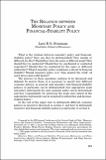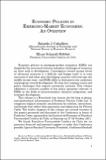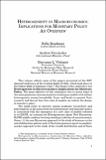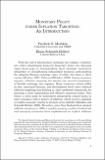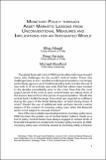Search
Now showing items 1-10 of 569
Monetary policy and financial stability: transmission mechanisms and policy implications: an overview
Financial stability understood as a situation when the financial system smoothly performs its function of allocating capital and adverse shocks are unlikely to be amplified has been for long a key concern for policymakers and in particular for monetary authorities. However until 10 years ago most ...
The relation between monetary policy and financial-stability policy
What is the relation between monetary policy and financialstability policy? How can they be distinguished? How similar or different are they? Should they have the same or different goals? How should they be conducted? Should they be coordinated or conducted separately? Should they be conducted by the ...
Economic policies in emerging-market economies: an overview
Economic policies in emerging-market economies (EMEs) are shaped by the structural features and policy challenges of countries on their road to development. Convergence toward income levels of advanced countries is a difficult and bumpy road—it is even uncertain if and when most developing countries ...
Heterogeneity in macroeconomics: implications for monetary policy an overview
This volume collects some of the papers presented at the XXV Annual Conference of the Central Bank of Chile, which took place in
November 2022 in Santiago, Chile.1 The theme of the conference was Heterogeneity in Macroeconomics: Implications for Monetary
Policy. The main objective of this conference ...
The fiscal footprint of macroprudential policy
, and this creates seignorage revenues. Inflation unexpectedly rises and this lowers the real value of public debt. Rolling over this debt is cheaper as the price of newly issued debt rises. And finally, economic activity rises, so tax revenues increase and social...
Monetary policy under inflation targeting: an introduction
With the end of intermediate exchange rate regimes, countries are either abandoning domestic monetary policy (by choosing super-hard pegs or relinquishing their national currencies altogether) or strengthening independent monetary policymaking (by adopting floating exchange rates, of either the clean ...
Independence, credibility, and communication of central banking: an overview
. Whether during the Global Financial Crisis, through individual country slumps, or at the trough of the pandemic recession, independent central banks were typically part of the solution rather than part of the problem. Attacks on the independence of a...
Monetary policy thorugh asset markets: lessons from unconventional measures and implications for an integrated world
The global financial crisis of 2008 and its aftermath have brought many new challenges for the world’s central banks. These new challenges have in turn resulted in bold experimentation—not simply particularly vigorous use of traditional policy tools but also the use of new tools or if not entirely new ...
Monetary policy and global spillovers: mechanisms effects and policy measures: an overview
The global economy of today 'is a small world after all.' The high degree of international trade integration and financial interconnectedness has created tight linkages across most countries even between countries that may be very distant geographically or that may not have significant trade or financial ...
Risks to central-bank independence
their power or remit. These include everything from enhanced financial regulation to quasi-fiscal policy to mitigating economic inequality. Some recent populist proposals appear to be based on the presumption that central banks can issue large quantities...


